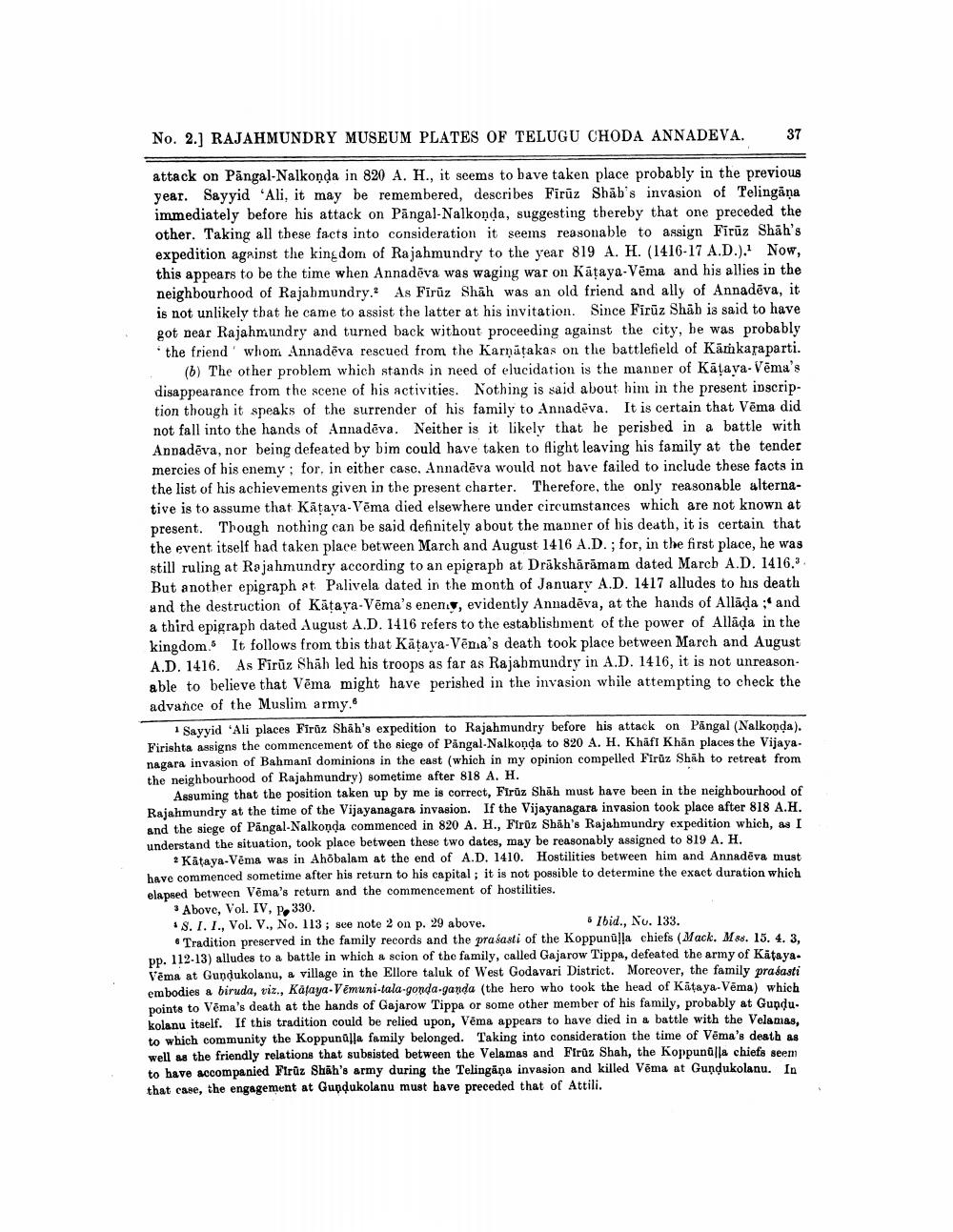________________
No. 2.] RAJAHMUNDRY MUSEUM PLATES OF TELUGU CHODA ANNADEVA.
attack on Pängal-Nalkonda in 820 A. H., it seems to have taken place probably in the previous year. Sayyid Ali, it may be remembered, describes Firuz Shab's invasion of Telingana immediately before his attack on Pāngal-Nalkonda, suggesting thereby that one preceded the other. Taking all these facts into consideration it seems reasonable to assign Firuz Shah's expedition against the kingdom of Rajahmundry to the year 819 A. H. (1416-17 A.D.). Now, this appears to be the time when Annadeva was waging war on Kataya-Vēma and his allies in the neighbourhood of Rajahmundry. As Firüz Shah was an old friend and ally of Annadēva, it is not unlikely that he came to assist the latter at his invitation. Since Firuz Shah is said to have got near Rajahmundry and turned back without proceeding against the city, he was probably the friend whom Annadeva rescued from the Karnatakas on the battlefield of Kamkaraparti.
37
(b) The other problem which stands in need of elucidation is the manner of Kataya- Vēma's disappearance from the scene of his activities. Nothing is said about him in the present inscription though it speaks of the surrender of his family to Annadeva. It is certain that Vēma did not fall into the hands of Annadeva. Neither is it likely that he perished in a battle with Annadeva, nor being defeated by bim could have taken to flight leaving his family at the tender mercies of his enemy; for, in either casc, Annadeva would not have failed to include these facts in the list of his achievements given in the present charter. Therefore, the only reasonable alternative is to assume that Kaṭaya-Vēma died elsewhere under circumstances which are not known at present. Though nothing can be said definitely about the manner of his death, it is certain that the event itself had taken place between March and August 1416 A.D.; for, in the first place, he was still ruling at Rajahmundry according to an epigraph at Draksharamam dated March A.D. 1416.". But another epigraph at Palivela dated in the month of January A.D. 1417 alludes to his death and the destruction of Kataya-Vema's enemy, evidently Annadeva, at the hands of Allaḍa; and a third epigraph dated August A.D. 1416 refers to the establishment of the power of Allaḍa in the kingdom. It follows from this that Käṭaya-Vema's death took place between March and August A.D. 1416. As Firuz Shah led his troops as far as Rajahmundry in A.D. 1416, it is not unreasonable to believe that Vēma might have perished in the invasion while attempting to check the advance of the Muslim army.
1 Sayyid Ali places Firüz Shah's expedition to Rajahmundry before his attack on Pängal (Nalkonda). Firishta assigns the commencement of the siege of Pängal-Nalkonda to 820 A. H. Khäft Khän places the Vijaya. nagara invasion of Bahmani dominions in the east (which in my opinion compelled Firüz Shah to retreat from the neighbourhood of Rajahmundry) sometime after 818 A. H.
Assuming that the position taken up by me is correct, Firüz Shah must have been in the neighbourhood of Rajahmundry at the time of the Vijayanagara invasion. If the Vijayanagara invasion took place after 818 A.H. and the siege of Pangal-Nalkonda commenced in 820 A. H., Firüz Shah's Rajahmundry expedition which, as I understand the situation, took place between these two dates, may be reasonably assigned to 819 A. H.
2 Kataya-Vēma was in Ahōbalam at the end of A.D. 1410. Hostilities between him and Annadeva must have commenced sometime after his return to his capital; it is not possible to determine the exact duration which elapsed between Vema's return and the commencement of hostilities.
Above, Vol. IV, P. 330.
S. I. I., Vol. V., No. 113; see note 2 on p. 29 above.
5 Ibid., No. 133.
Tradition preserved in the family records and the prasasti of the Koppunülla chiefs (Mack. Mss. 15. 4. 3, pp. 112-13) alludes to a battle in which a scion of the family, called Gajarow Tippa, defeated the army of Kataya. Vēma at Gundukolanu, a village in the Ellore taluk of West Godavari District. Moreover, the family prasasti embodies a biruda, viz., Kataya-Vemuni-tala-gonda-ganda (the hero who took the head of Kataya-Vēma) which points to Vema's death at the hands of Gajarow Tippa or some other member of his family, probably at Gundu. kolanu itself. If this tradition could be relied upon, Vêma appears to have died in a battle with the Velamas, to which community the Koppunulla family belonged. Taking into consideration the time of Vema's death as well as the friendly relations that subsisted between the Velamas and Firüz Shah, the Koppunulla chiefs seem to have accompanied Firüz Shah's army during the Telingana invasion and killed Vēma at Gundukolanu. In that case, the engagement at Gundukolanu must have preceded that of Attili.




